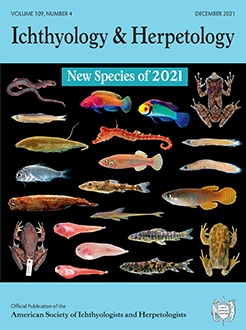This study investigated larval catfish abundance and diversity in various fluvial habitats in the Amazon lowlands of eastern Ecuador. It assessed the relationship between spawning behavior and the hydrological cycle, identified a potential spawning site, and elucidated community assemblages based on larval diversity among river tributaries with differing water chemistry profiles. Sampling sites included the mainstreams of the Napo and Aguarico Rivers and lower reaches of three tributaries. Drift samples were taken before, during, and after strong, rain-induced flooding occurred. Results suggest a strong peak of larval abundances in April, coinciding with the start of the flood period. In the Napo mainstream, samples were dominated by larvae of large migratory pimelodid catfishes, Pseudoplatystoma spp., which were caught between the upriver site in the foothills (254 m a.s.l.) and the downstream Peruvian frontier (175 m a.s.l.). Back-calculations based on water velocity and larval growth rate suggest that most of these larvae originated in the lowlands between those two locations, where the riverbed transitions from rocky to sandy/silty substrate. Thus, it appears that most spawning occurred over sandy substrates rather than the rocky substrates that were dominant above the upriver site. Comparisons of samples taken by day and night at the same sites revealed significantly higher larval abundances at night; thus, larvae must either preferentially drift at night, actively avoid the nets by day, or may do diel vertical migrations (e.g., related to predation pressure or pursuit of prey items). Dominant larval taxa in the whitewater mainstreams differed from those dominating samples from a blackwater mainstream system, and catfish larval assemblages in each of those habitats were distinct from those drifting in small, blackwater tributaries. These results provide key life-history information for catfish species in the Napo River, including for important commercial species, such as Pseudoplatystoma spp. Identification and protection of discrete spawning sites, such as those identified here, are critical to conservation efforts for these species.
BioOne.org will be down briefly for maintenance on 17 December 2024 between 18:00-22:00 Pacific Time US. We apologize for any inconvenience.
How to translate text using browser tools
22 October 2021
Spatial and Temporal Patterns of Pelagic Catfish Larvae Drifting in Lowland Rivers of Eastern Ecuador (Pisces: Siluriformes)
Theodore W. Hermann,
Donald J. Stewart,
Ramiro E. Barriga Salazar,
Stephen M. Coghlan Jr.
ACCESS THE FULL ARTICLE

Ichthyology & Herpetology
Vol. 109 • No. 4
December 2021
Vol. 109 • No. 4
December 2021




